英语句子分类
- 格式:ppt
- 大小:346.00 KB
- 文档页数:63
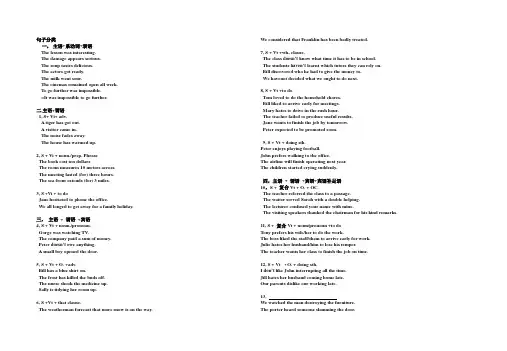
句子分类一,主语+系动词+表语The lesson was interesting.The damage appears serious.The soup tastes delicious.The actors got ready.The milk went sour.The cinemas remained open all week.To go further was impossible.=It was impossible to go further.二,主语+谓语1, S+ Vi+ adv.A tiger has got out.A visitor came in.The noise fades away.The house has warmed up.2, S + Vi + noun./prep. PhraseThe book cost ten dollarsThe room measures 10 meters across.The meeting lasted (for) three hours.The sea front extends (for) 3 miles.3, S +Vi + to doJane hesitated to phone the office.We all longed to get away for a family holiday.三,主语+ 谓语+宾语4, S + Vt + noun./pronoun.Gorge was watching TV.The company paid a sum of money.Peter doesn’t owe anything.A small boy opened the door.5, S + Vt + O. +adv.Bill has a blue shirt on.The frost has killed the buds off.The nurse shook the medicine up.Sally is tidying her room up.6, S +Vt + that clause.The weatherman forecast that more snow is on the way. We considered that Franklin has been badly treated.7, S + Vt +wh- clause.The class doesn’t know what time it has to be in school.The students haven’t learnt which tutors they can rely on.Bill discovered who he had to give the money to.We havenot decided what we ought to do next.8, S + Vt +to doTom loved to do the household chores.Bill liked to arrive early for meetings.Mary hates to drive in the rush hour.The teacher failed to produce useful results.Jane wants to finish the job by tomorrow.Peter expected to be promoted soon.9, S + Vt + doing sth.Peter enjoys playing football.John prefers walking to the office.The airline will finish operating next year.The children started crying suddenly.四,主语+ 谓语+宾语+宾语补足语10,S + 复合Vt + O. + OC.The teacher referred the class to a passage.The waiter served Sarah with a double helping.The lecturer confused your name with mine.The visiting speakers thanked the chairman for his kind remarks. 11, S + 复合Vt + noun/pronoun +to doTony prefers his wife/her to do the work.The boss liked the staff/them to arrive early for work.Julie hates her husband/him to lose his temper.The teacher wants her class to finish the job on time.12, S + Vt + O. + doing sth.I don’t like John interrupting all the time.Jill hates her husband coming home late.Our parents dislike our working late.13,We watched the man destroying the furniture.The porter heard someone slamming the door.The children saw the cat stealing the meat.14,We watched the man destroy the furniture.The porter heard someone destroy the furniture. The children saw the cat steal the meat.15,I imagined him much taller than that.Jane prefers her coffee black.Peter has a tooth lose.The fridge keeps the beer cool.The mayor declared the meeting open.16,We made Frank chairman.We declared Jones the winner.The court considered Mr. Smiths a trustworthy man. The police didn’t accept the story as genuine.The club won’t appoint a teenager as the leader. 17,The reporter pressed her to answer the question. The thief forced Jane to hand over the money.The extra money helped John to be independent.An official declared the place to be free of infection. 18,This remark set everyone thinking.The look on Bill’s face had me trembling with fear. The policeman got the traffic moving.The driver kept his engine running.19,His tutor made him work.Mother won’t let the children play in the road. Stephen helped us organize the party.五,主语+ 谓语+双宾语20,The queen awarded the pilot a gallantry medal.The waiter poured Sarah a glass of water.Henry taught the children French. Christina will lend us her flat.I will make everyone some fresh coffee.21,The queen awarded the medal to the pilot.The waiter poured a glass of water for Sarah.Henry taught French to the children.Christina will lend the flat to us.I will make some fresh coffee for everyone.22,Colleagues told Paul that the job wouldn’t be easy.The manager informed the audience that the show had been cancelled.Police warned the driver that the roads were icy.23The employers announced to the journalists that the dispute had been settled.The consultant recommended to the employers that the salary scale should be introduced. The garage explained to the customers that the small parts had been delivered..24,A friendly guard showed the prisoner how he would escape/how to escape/.The porter reminded guest where they should leave the luggage/where to leave the luggage. Experience hasn’t taught Martha whom she can trust/ who to trust.25,We explained to the staff how they should handle complaints/ how to handle complaints. 26,We told peter to see a doctor.His teacher advised him to learn music.The court forbade the father to see his children.27,She gestured to the children to stand up.Stephen shouted to the waiter to bring another chair.A police motioned (示意) to us to move to the roadside.。
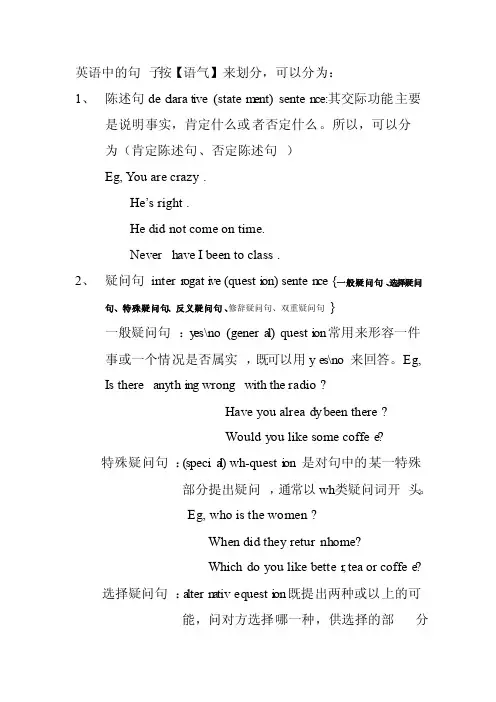
英语中的句子按【语气】来划分,可以分为:1、陈述句dec larat ive (statem ent) sentence:其交际功能主要是说明事实,肯定什么或者否定什么。
所以,可以分为(肯定陈述句、否定陈述句)Eg, You are crazy.He’s right.He did not come on time.Neverhave I been to class.2、疑问句interr ogati ve (questi on) sentence {一般疑问句、选择疑问句、特殊疑问句、反义疑问句、修辞疑问句、双重疑问句}一般疑问句:y es\no (genera l) questi on常用来形容一件事或一个情况是否属实,既可以用yes\no 来回答。
Eg,Is thereanything wrongwith the radio?Have you already been there?Wouldyou like some coffee?特殊疑问句:(specia l) wh-questi on 是对句中的某一特殊部分提出疑问,通常以wh类疑问词开头。
Eg, who is the women?When did they return home?Whichdo you like better, tea or coffee?选择疑问句:a ltern ative questi on既提出两种或以上的可能,问对方选择哪一种,供选择的部分用or连接,前升后降。
(结构可以是一般疑问句、特殊疑问句)Eg, will you go thereby bus or by train?How many pens do you have, two orthree?Is it right or wrong?反义疑问句: tag questi on 标签,附属物。
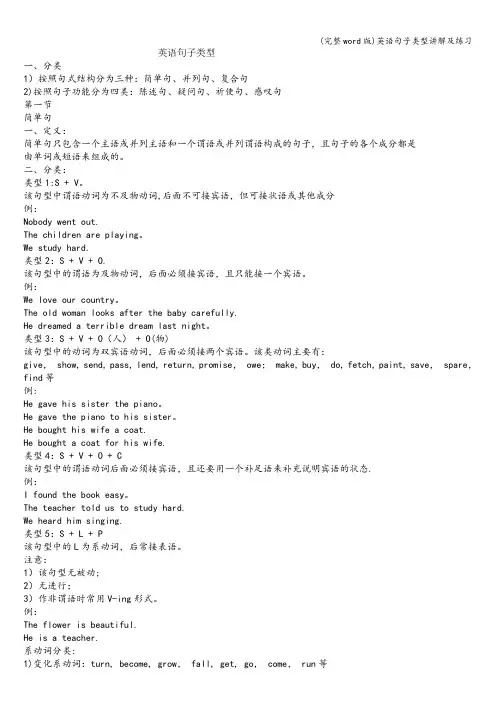
英语句子类型一、分类1)按照句式结构分为三种:简单句、并列句、复合句2)按照句子功能分为四类:陈述句、疑问句、祈使句、感叹句第一节简单句一、定义:简单句只包含一个主语或并列主语和一个谓语或并列谓语构成的句子,且句子的各个成分都是由单词或短语来组成的。
二、分类:类型1:S + V。
该句型中谓语动词为不及物动词,后面不可接宾语,但可接状语或其他成分例:Nobody went out.The children are playing。
We study hard.类型2:S + V + O.该句型中的谓语为及物动词,后面必须接宾语,且只能接一个宾语。
例:We love our country。
The old woman looks after the baby carefully.He dreamed a terrible dream last night。
类型3:S + V + O(人) + O(物)该句型中的动词为双宾语动词,后面必须接两个宾语。
该类动词主要有:give, show, send, pass, lend, return, promise, owe; make, buy, do, fetch, paint, save, spare,find等例:He gave his sister the piano。
He gave the piano to his sister。
He bought his wife a coat.He bought a coat for his wife.类型4:S + V + O + C该句型中的谓语动词后面必须接宾语,且还要用一个补足语来补充说明宾语的状态.例:I found the book easy。
The teacher told us to study hard.We heard him singing.类型5:S + L + P该句型中的L为系动词,后常接表语。
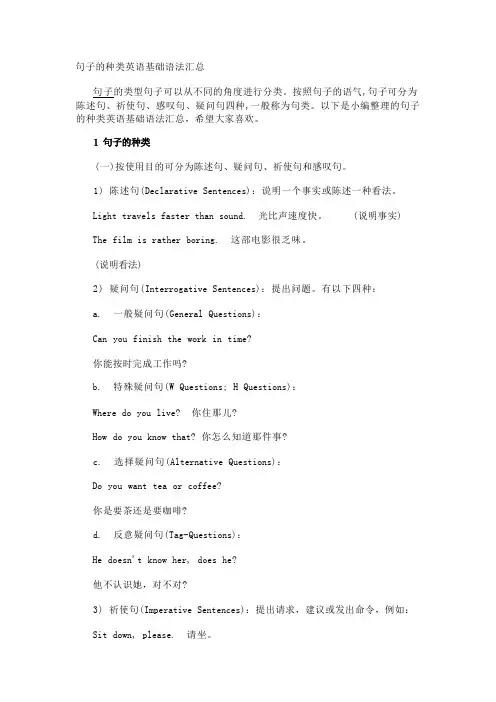
句子的种类英语基础语法汇总句子的类型句子可以从不同的角度进行分类。
按照句子的语气,句子可分为陈述句、祈使句、感叹句、疑问句四种,一般称为句类。
以下是小编整理的句子的种类英语基础语法汇总,希望大家喜欢。
(一)按使用目的可分为陈述句、疑问句、祈使句和感叹句。
1) 陈述句(Declarative Sentences):说明一个事实或陈述一种看法。
Light travels faster than sound. 光比声速度快。
(说明事实)The film is rather boring. 这部电影很乏味。
(说明看法)2) 疑问句(Interrogative Sentences):提出问题。
有以下四种:a. 一般疑问句(General Questions):Can you finish the work in time?你能按时完成工作吗?b. 特殊疑问句(W Questions; H Questions):Where do you live? 你住那儿?How do you know that? 你怎么知道那件事?c. 选择疑问句(Alternative Questions):Do you want tea or coffee?你是要茶还是要咖啡?d. 反意疑问句(Tag-Questions):He doesn't know her, does he?他不认识她,对不对?3) 祈使句(Imperative Sentences):提出请求,建议或发出命令,例如:Sit down, please. 请坐。
Don't be nervous! 别紧张!4) 感叹句(Exclamatory Sentences):表示说话人惊奇、喜悦、愤怒等情绪,例如:What good news it is! 多好的消息啊!(二)句子按其结构可以分为以下三类:1) 简单句(Simple Sentences):只包含一个主谓结构句子叫简单句,例如:She is fond of collecting stamps. 她喜欢集邮。
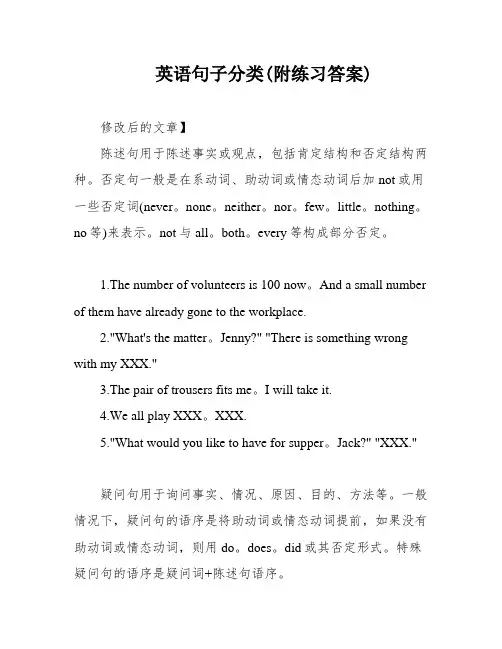
英语句子分类(附练习答案)修改后的文章】陈述句用于陈述事实或观点,包括肯定结构和否定结构两种。
否定句一般是在系动词、助动词或情态动词后加not或用一些否定词(never。
none。
neither。
nor。
few。
little。
nothing。
no等)来表示。
not与all。
both。
every等构成部分否定。
1.The number of volunteers is 100 now。
And a small number of them have already gone to the workplace.2."What's the matter。
Jenny?" "There is something wrong with my XXX."3.The pair of trousers fits me。
I will take it.4.We all play XXX。
XXX.5."What would you like to have for supper。
Jack?" "XXX."疑问句用于询问事实、情况、原因、目的、方法等。
一般情况下,疑问句的语序是将助动词或情态动词提前,如果没有助动词或情态动词,则用do。
does。
did或其否定形式。
特殊疑问句的语序是疑问词+陈述句语序。
1."Is the girl in red your friend?" "No。
she is learning Chinese now."2."When will the match een HAS and BIG be held?" "In our school stadium."3.How often do you volunteer in the Old People's Home。
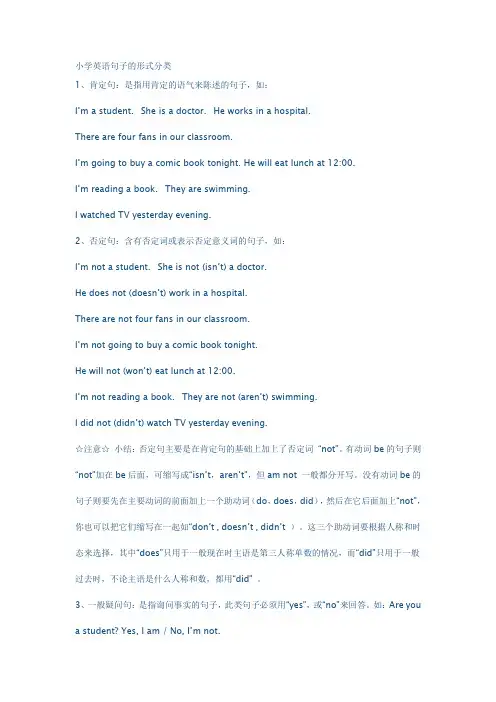
小学英语句子的形式分类1、肯定句:是指用肯定的语气来陈述的句子,如:I’m a student.She is a doctor. He works in a hospital.There are four fans in our classroom.I’m going to buy a comic book tonight. He will eat lunch at 12:00.I’m reading a book.They are swimming.I watched TV yesterday evening.2、否定句:含有否定词或表示否定意义词的句子,如:I’m not a student.She is not (isn’t) a doctor.He does not (doesn’t) work in a hospital.There are not four fans in our classroom.I’m not going to buy a comic book tonight.He will not (won’t) eat lunch at 12:00.I’m not reading a book.They are not (aren’t) swimming.I did not (didn’t) watch TV yesterday evening.☆注意☆小结:否定句主要是在肯定句的基础上加上了否定词“not”。
有动词be的句子则“not”加在be后面,可缩写成“isn’t,aren’t”,但am not 一般都分开写。
没有动词be的句子则要先在主要动词的前面加上一个助动词(do,does,did),然后在它后面加上“not”,你也可以把它们缩写在一起如“don’t , doesn’t , didn’t )。
这三个助动词要根据人称和时态来选择,其中“does”只用于一般现在时主语是第三人称单数的情况,而“did”只用于一般过去时,不论主语是什么人称和数,都用“did” 。
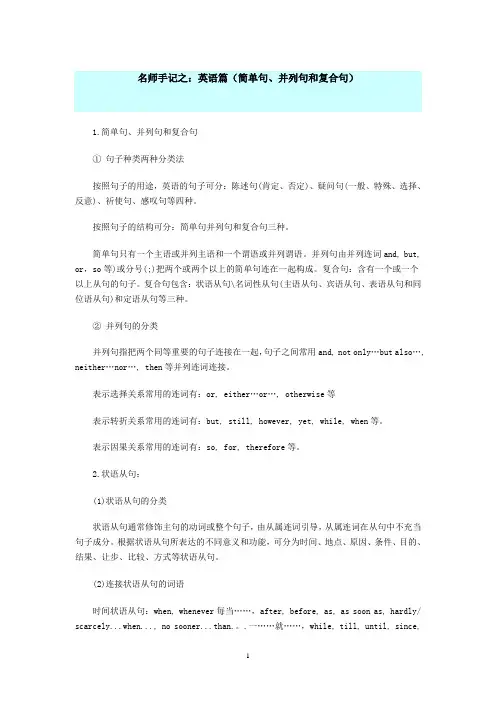
名师手记之:英语篇(简单句、并列句和复合句)1.简单句、并列句和复合句① 句子种类两种分类法按照句子的用途,英语的句子可分:陈述句(肯定、否定)、疑问句(一般、特殊、选择、反意)、祈使句、感叹句等四种。
按照句子的结构可分:简单句并列句和复合句三种。
简单句只有一个主语或并列主语和一个谓语或并列谓语。
并列句由并列连词and, but, or,so等)或分号(;)把两个或两个以上的简单句连在一起构成。
复合句:含有一个或一个以上从句的句子。
复合句包含:状语从句\名词性从句(主语从句、宾语从句、表语从句和同位语从句)和定语从句等三种。
② 并列句的分类并列句指把两个同等重要的句子连接在一起,句子之间常用and, not only…but also…, neither…nor…, then等并列连词连接。
表示选择关系常用的连词有:or, either…or…, otherwise等表示转折关系常用的连词有:but, still, however, yet, while, when等。
表示因果关系常用的连词有:so, for, therefore等。
2.状语从句:(1)状语从句的分类状语从句通常修饰主句的动词或整个句子,由从属连词引导,从属连词在从句中不充当句子成分。
根据状语从句所表达的不同意义和功能,可分为时间、地点、原因、条件、目的、结果、让步、比较、方式等状语从句。
(2)连接状语从句的词语时间状语从句:when, whenever每当……,after, before, as, as soon as, hardly/ scarcely...when..., no sooner...than.。
.一……就……,while, till, until, since,once。
名词词组the first time第一次,last time最后一次,every/each time每次,the next time下次,the next day第二天, the moment, the minute, the second, the instant 一……就……;副词immediately, instantly, directly等也可作连词使用。
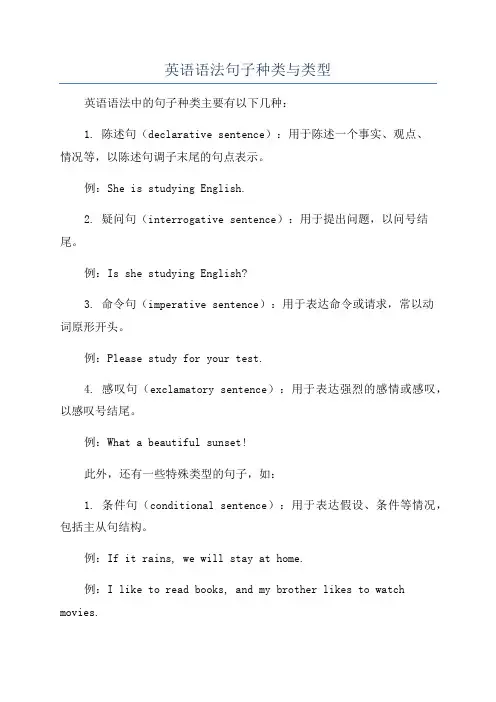
英语语法句子种类与类型
英语语法中的句子种类主要有以下几种:
1. 陈述句(declarative sentence):用于陈述一个事实、观点、
情况等,以陈述句调子末尾的句点表示。
例:She is studying English.
2. 疑问句(interrogative sentence):用于提出问题,以问号结尾。
例:Is she studying English?
3. 命令句(imperative sentence):用于表达命令或请求,常以动
词原形开头。
例:Please study for your test.
4. 感叹句(exclamatory sentence):用于表达强烈的感情或感叹,以感叹号结尾。
例:What a beautiful sunset!
此外,还有一些特殊类型的句子,如:
1. 条件句(conditional sentence):用于表达假设、条件等情况,包括主从句结构。
例:If it rains, we will stay at home.
例:I like to read books, and my brother likes to watch movies.
3. 从句(subordinate clause):作为主句的一部分,常用连接词引导,包括定语从句、名词性从句和状语从句等。
例:The book that I bought yesterday is very interesting.。
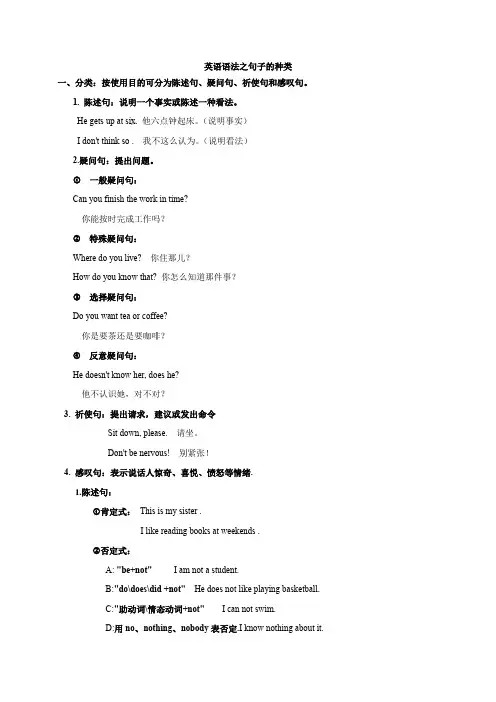
英语语法之句子的种类一、分类:按使用目的可分为陈述句、疑问句、祈使句和感叹句。
1. 陈述句:说明一个事实或陈述一种看法。
He gets up at six. 他六点钟起床。
(说明事实)I don't think so .我不这么认为。
(说明看法)2.疑问句:提出问题。
①一般疑问句:Can you finish the work in time?你能按时完成工作吗?②特殊疑问句:Where do you live?你住那儿?How do you know that? 你怎么知道那件事?③选择疑问句:Do you want tea or coffee?你是要茶还是要咖啡?④反意疑问句:He doesn't know her, does he?他不认识她,对不对?3. 祈使句:提出请求,建议或发出命令Sit down, please.请坐。
Don't be nervous!别紧张!4. 感叹句:表示说话人惊奇、喜悦、愤怒等情绪.1.陈述句:①肯定式:This is my sister .I like reading books at weekends .②否定式:A: "be+not" I am not a student.B:"do\does\did +not" He does not like playing basketball.C:"助动词\情态动词+not" I can not swim.D:用no、nothing、nobody表否定.I know nothing about it.2. 一般疑问句:①定义:用be动词、助动词或情态动词置于句首,可用“yes”或“no”来回答的问句。
②应答:用yes\no(或相当于“yes”或“no”的词)回答,并根据句首的be动词、情态动词或助动词作相应的回答。
--Is Mary a Japanese girl ? --Yes,she is.\No,she isn't.--Can you speak English? --Yes,I can .\No, I can't .--Do you like your teacher ? --Yes,I do.\No, I don't .③变形:如何将一个肯定的陈述句变为一般疑问句:A:看句中有无be动词,如果有be动词提到句首即可。
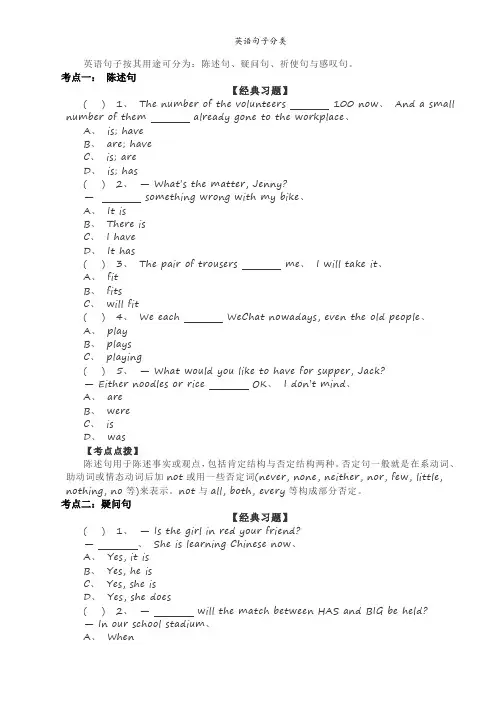
英语句子按其用途可分为:陈述句、疑问句、祈使句与感叹句。
考点一:陈述句【经典习题】( ) 1、The number of the volunteers 100 now、And a small number of them already gone to the workplace、A、is; haveB、are; haveC、is; areD、is; has( ) 2、—What’s the matter, Jenny?— something wrong with my bike、A、It isB、There isC、I haveD、It has( ) 3、The pair of trousers me、I will take it、A、fitB、fitsC、will fit( ) 4、We each WeChat nowadays, even the old people、A、playB、playsC、playing( ) 5、— What would you like to have for supper, Jack?— Either noodles or rice OK、I don’t mind、A、areB、wereC、isD、was【考点点拨】陈述句用于陈述事实或观点,包括肯定结构与否定结构两种。
否定句一般就是在系动词、助动词或情态动词后加not或用一些否定词(never, none, neither, nor, few, little, nothing, no等)来表示。
not与all, both, every等构成部分否定。
考点二:疑问句【经典习题】( ) 1、— Is the girl in red your friend?—、She is learning Chinese now、A、Yes, it isB、Yes, he isC、Yes, she isD、Yes, she does( ) 2、— will the match between HAS and BIG be held?— In our school stadium、A、WhenB、WhereC、WhyD、How( ) 3、—do you volunteer in Old People’s Home?— Once a week、We hope to help the old more、A、How soonB、How manyC、How oftenD、How long( ) 4、— Bill, does your sister have brown hair or red hair?—、She takes after my mother、A、Yes, she doesB、No, she doesn’tC、Brown hairD、I don’t know( ) 5、He can hardly stay awake because he is so tired, ?A、is heB、isn’t heC、can’t heD、can he【考点点拨】疑问句用于提出问题,包括一般疑问句、特殊疑问句、选择疑问句与反意疑问句。
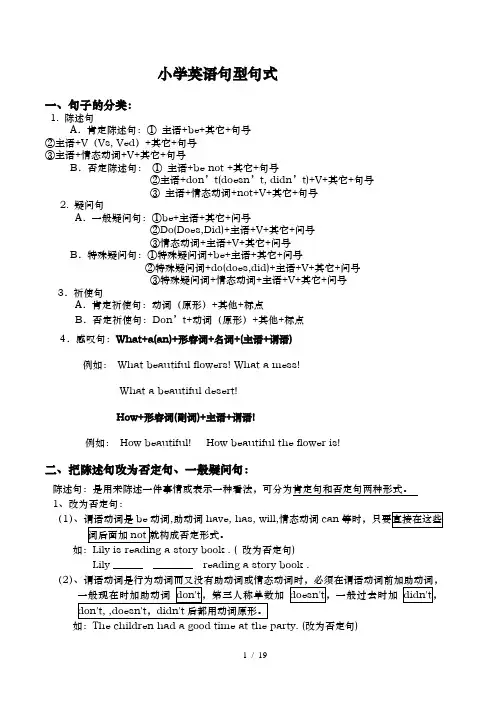
小学英语句型句式一、句子的分类:1. 陈述句A.肯定陈述句:①主语+be+其它+句号②主语+V(Vs, Ved)+其它+句号③主语+情态动词+V+其它+句号B.否定陈述句:①主语+be not +其它+句号②主语+don’t(doesn’t, didn’t)+V+其它+句号③主语+情态动词+not+V+其它+句号2. 疑问句A.一般疑问句:①be+主语+其它+问号②Do(Does,Did)+主语+V+其它+问号③情态动词+主语+V+其它+问号B.特殊疑问句:①特殊疑问词+be+主语+其它+问号②特殊疑问词+do(does,did)+主语+V+其它+问号③特殊疑问词+情态动词+主语+V+其它+问号3.祈使句A.肯定祈使句:动词(原形)+其他+标点B.否定祈使句:Don’t+动词(原形)+其他+标点4.感叹句:What+a(an)+形容词+名词+(主语+谓语)例如:What beautiful flowers! What a mess!What a beautiful desert!How+形容词(副词)+主语+谓语!例如:How beautiful! How beautiful the flower is!二、把陈述句改为否定句、一般疑问句:陈述句:是用来陈述一件事情或表示一种看法,可分为肯定句和否定句两种形式。
1、改为否定句:(1)、谓语动词是be动词,助动词have, has, will,情态动词can改为否定句)Lily ______ ________ reading a story book .(2改为否定句)The children _________ _________ a good time at the party.2、改为一般疑问句:be动词, have /has/do等助动词、can/may/will等情态动词开头,以(1be改为一般疑问句)___________________(2)、谓语动词是行为动词时,必须在句首加上助动词如:)__________________________________________________注意:在把肯定句改成否定句或一般疑问句的时候,要注意句中是否有already、some、something、somebody等词,如果有也必须进行改变,already要改成yet,some、something、somebody等分别改成any、anything、anybody等。
英语句子的分类
英语句子类型按句子的用途分为四种:陈述句、疑问句、祈使句、感叹句。
1、陈述句(Declarative Sentence)是陈述一个事实或者说话人的看法的句型。
陈述句又分为肯定的陈述句和否定的陈述句,简称为肯定句(The Affirmative Sentence)和否定句(The Negative Sentence)。
2、疑问句是按照句子的语气分出来的一个类,它与陈述句、感叹句、祈使句的最大区别就是它的疑问语气;是问一些事情的,表达的内容并不是陈述,所以是不确定的;主要有四大句型,一般疑问句、选择疑问句、特殊疑问句和反意疑问句。
3、祈使句(Imperative Sentence)是英语中的一个句式,也是用于表达命令、请求、劝告、警告、禁止等的句子。
祈使句最常用于表达命令,因此在学校文法中也常称为命令句。
4、感叹句有多种表现形式,有时一个单词、短语或一个词组也可成为感叹句。
有时陈述句、疑问句以及祈使句也可以转化成感叹句。
英语句子的分类英语句子按其语法结构可以分为简单句、并列句和复合句三种类型。
1. 简单句(Simple Sentence):只有一个主谓结构的句子。
例如:1) Things change.2) Fire and water do not agree.3) He came into the classroom and sit down.2. 并列句(Compound Sentence):包含两个或两个以上互不依从的主谓结构的句子。
并列句的各个分句常用一定的并列连词(coordinating conjunction)(FAN BOYS)、连接副词(conjunctive adverbs)和分号(semicolon)连接在一起。
例如:1) I hate jogging, but I love hiking.2) Fishes must stay in water, or they will die.3) Punctuation is important; therefore, don’t forget to use a comma before the coordinating conjunction in a compound sentence.4) This is the best book I have ever read; it kept me up all night.3. 复合句(Complex Sentence):由一个主句(main clause)和至少一个从句(subordinate clause)构成的句子。
从句须用关联词(connective)引导,来表明与主句的关系。
例如:1) She loves her dog as a mother loves her child.2) Although many people were unknown to each other before, they have got acquainted with each other through e-mail.3) When you go for a job interview, it is important to create a good fist impression.4. 并列复合句(Compound-Complex Sentence),例如:1). Jack, who reads comics, rarely reads novels; however, Tom enjoysnovels.2). While the men worked to strengthen the dam, the rain continued to fall, and the river, which was already well above its normal level, rose higher and higher.。
初中英语知识归纳总结——句子的分类句子的分类(一)教学重点简单句及简单句的五种基本句型1、SVC结构(主语+系动词+表语)在这种句型中,动词必须是系动词,在动词之后跟有表语。
表语可以是名词(词组),形容词(词组),副词(词组)等。
如:The teacher is kind.She looks fine.My son became a doctor at last.系动词除be外,常见的还有keep, look, feel, smell, sound, taste, grow, get, go, turn2、SV结构(主语+不及物动词)(1) 在这个结构中,动词是不及物动词,动词后边没有宾语,如:My head aches.He is singing.(2) 有些动词后边必须带有状语,否则意思就不明确。
如:The professor lives in Beijing.We stayed in China for a few days.常见的不及物动词有:sleep, walk, swim, happen, take place, go, come, work, laugh, stay.3、SVO结构(主语+及物动词+宾语)在这个结构中,谓语动词必须是及物动词,在动词后边跟有宾语。
He can drive a car.They speak English.有些不及物动词后面加上介词或副词可以把它看成一个及物动词,这时后边可接宾语。
Please listen to me carefully.4、SVOO结构(主语+动词+间接宾语+直接宾语)(1) 双宾语结构在这个结构中,动词是带有双宾语(直接宾语和间接宾语)的及物动词。
直接宾语多指物,间接宾语多指人。
常用的带有双宾语的动词有:give, send, tell, bring, lend, buy, teach, get, call, do, ask, wish, offer等。
英语词类(共分10类)词类缩写例词用法名词n. John,room 主,宾,表动词v. stand ,be 谓形容词adj good,interesting 定副词adv. almost ,bravely 状代词pron. them,everything 主,宾,表连词conj. and ,but,because, that, while 不做成分介词prep. near,from, in, on, at 不做成分数词num. nine,first 定,表冠词art. a,an,the 不做成分感叹词interj. hello ,oh, well 不做成分英语句子结构及分类一、简单句(5种句型)句型1:SV 结构(Subject 主语+Verb 谓语)1)Liu Xiaoqing married again.刘晓庆又结婚了。
主语谓语状语2) The accident happened yesterday afternoon.事故是昨天下午发生的。
3)Spring is coming.4) We have lived in the city for ten years.句型2:SLP结构(Subject 主语+Link. V系动词+Predicate表语)1) Liu Xiaoqing is an actress.刘晓庆是个演员。
主语系动词表语2) This kind of food tastes delicious.这种食物吃起来很可口。
3) He looked worried just now.刚才他看上去有些焦急。
4) Spring has come. It is getting warmer and warmer.春天到了,天气变得越来越暖和。
5) The tree has grown much taller than before.这棵树比以前长得高多了。
句型3:SVO结构(主语+Verb谓语+Object宾语)1) I love Liu Xiaoqing. Unfornately, she doesn’t love me.主语谓语宾语状语主语谓语宾语我爱刘晓庆。
英语修辞学家将句子按语法分类1.从句子结构来看,句子可分为:(1)简单句:只有一个主语部分和一个谓语部分。
如:Confidence in yourself is the first step on the road to success.自信是迈向成功的第一步。
(主语Confidence in your self,系动词is,表语the first step. . . )(2)并列句:包括两个或两个以上的简单句,中间常由并列连词连接,如:Fields have eyes, and woods have ears.隔墙有耳。
(and连接两个简单句)(3)复合句:由主句和从句构成,内含一个或一个以上的从句。
其中,主句是能够独立存在并能表达一个完整意思的分句;而从句则是依附主句,在主句中充当一个句子成分的分句,一般由连词、关系代词或关系副词所引导。
从句在句中可用作主语、表语、宾语、定语、状语、同位语、等句子成分,主要的从句有:主语从句,如:What he needs is that book. 他需要的是那本书。
表语从句,如:Fame and personal gain is what they're after. 他们追求的是名利。
宾语从句,如:Have you decided whom you are to nominate as your candidate?你们已经决定了提名谁当候选人吗?定语从句,如:This is the thing I want to say. 这就是我要说的。
状语从句,如:Strike while the iron is hot. 趁热打铁。
同位语从句,如:Word came that he had been abroad. 据说他已经出国了。
(4)并列复合句:由一个复合句和另一个简单句或复合句由并列连词(可用分号代替and)连接而成的句子。
如:The policeman looked at me suspiciously, and he asked me what I wanted.警察狐疑地打量着我,问我要干什么。